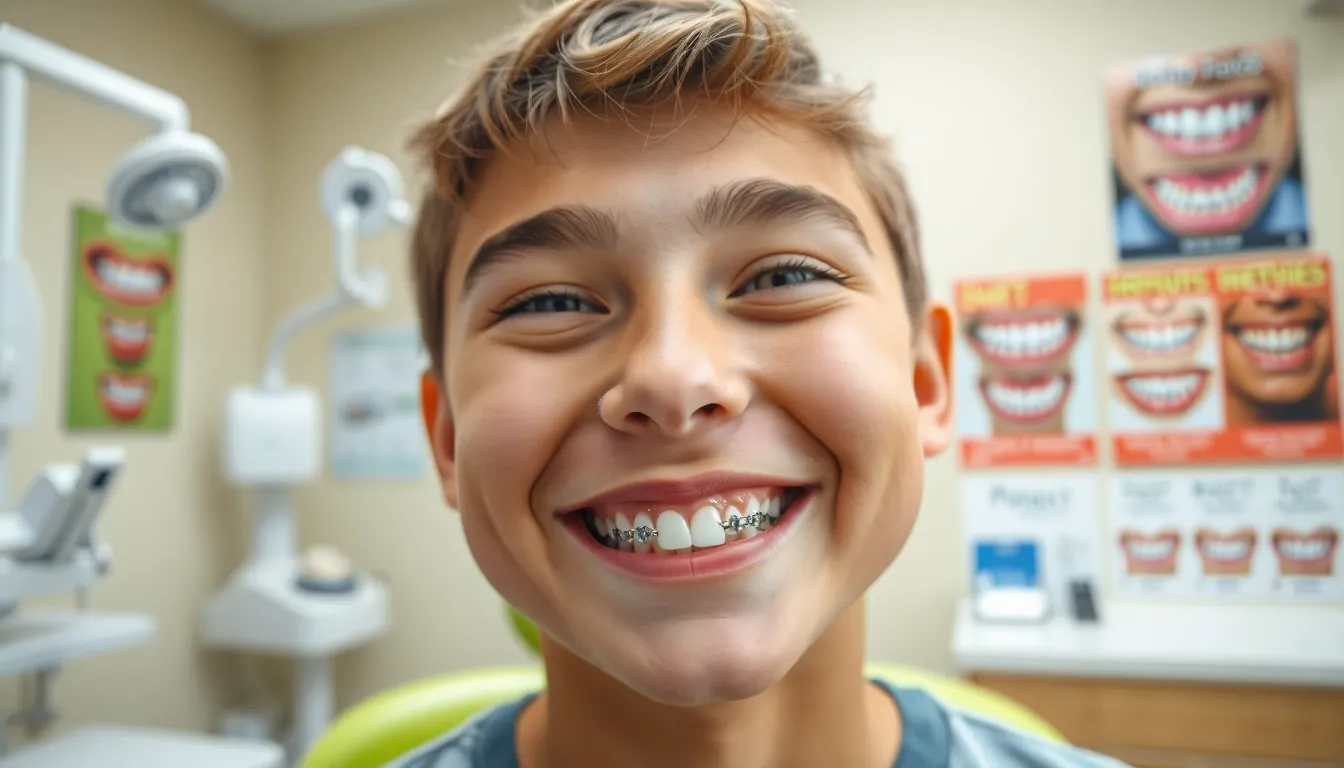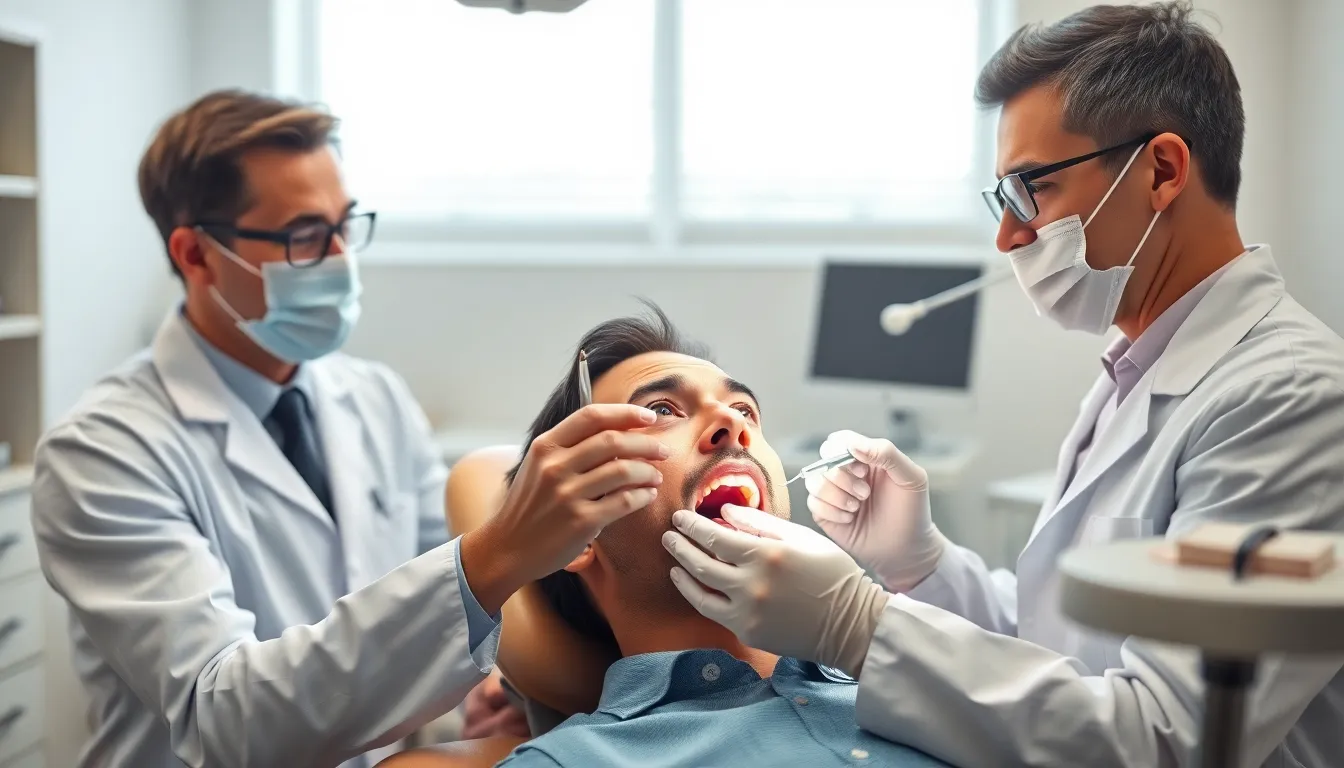When do braces start to work? If you’ve recently gotten orthodontic treatment or are considering it, you’re probably eager to see results from your investment.
Most patients notice initial changes within the first month of wearing braces, though visible improvements in tooth alignment typically appear around the 3-6 month mark. Your experience will depend on several factors including the severity of your dental issues, the type of braces you’ve chosen, and how consistently you follow your orthodontist’s instructions. While the journey to a perfect smile takes time, you’ll likely be surprised by how quickly the transformation begins.
Understanding How Braces Work
Braces work by applying consistent pressure to teeth, gradually shifting them into proper alignment. This orthodontic process combines biological changes with mechanical forces to transform your smile over time.
The Mechanics Behind Orthodontic Treatment
Orthodontic treatment relies on a simple yet sophisticated system of brackets, wires, and bands working together to move teeth. Brackets attach to each tooth’s surface using special dental adhesive, creating anchor points for the archwire that threads through them. This archwire exerts gentle, constant pressure on teeth, while elastic bands connect brackets to create additional directional force when needed.
Your orthodontist adjusts these components throughout your treatment, tightening the archwire or changing elastic configurations to guide teeth into their ideal positions. These adjustments create pressure on one side of a tooth while simultaneously creating tension on the opposite side. This pressure-tension ever-changing stimulates cellular activity in your jawbone, breaking down bone tissue on the pressure side and building new bone on the tension side—a process called bone remodeling.
Dr. Harris often tells patients, “Think of your braces as tiny construction workers, breaking down obstacles and rebuilding the foundation of your smile 24 hours a day.”
Timeline of Tooth Movement
Tooth movement with braces follows a predictable biological sequence. Within the first 24-72 hours after braces placement or adjustment, the periodontal ligament (the tissue connecting teeth to bone) becomes compressed and blood flow decreases on the pressure side. Cellular activity increases dramatically during this period, explaining why you feel soreness initially.
Days 3-7 mark the beginning of actual tooth movement as specialized cells called osteoclasts start breaking down bone on the pressure side. Meanwhile, on the tension side, osteoblasts begin forming new bone tissue. This coordinated cellular response enables teeth to move through the jawbone safely.
The most efficient tooth movement occurs between weeks 2-3 after each adjustment. Monthly appointments allow your orthodontist to evaluate progress and make necessary adjustments to maintain optimal pressure.
One patient, Sarah, shared her experience: “I was surprised when Dr. Harris explained that my teeth weren’t just moving through empty space but that my body was actually rebuilding bone around them. Understanding this process made me more patient with my treatment journey.”
Different teeth move at various rates—incisors typically shift faster than molars due to their smaller roots and less bone density. Front teeth often show improvement earliest, with changes becoming visible within 4-6 weeks of treatment initiation.
When Will You Start Feeling Braces Working?

Your teeth begin responding to braces immediately after placement, with physical sensations occurring before visible changes appear. The pressure applied by braces initiates the tooth movement process right away, though the timeline for feeling and seeing results varies from person to person.
Initial Discomfort and Pressure
Most patients experience some discomfort within the first 24-72 hours after getting braces. This soreness signals that your teeth are starting to respond to the orthodontic forces. The pressure sensation typically peaks around day 2-3 and gradually diminishes over the first week. Your lips and cheeks might also feel irritated as they adapt to the new hardware in your mouth.
Many of our patients describe the initial feeling as a dull, constant pressure rather than sharp pain. Sarah, a 16-year-old patient, shared: “The first night with my braces was uncomfortable, but by the end of the week, I barely noticed them except when eating.”
Applying orthodontic wax to brackets and taking over-the-counter pain relievers can help manage this adjustment phase. Soft foods like yogurt, mashed potatoes, and smoothies are easier to consume during the first few days when chewing sensitivity is at its peak.
Visual Changes Timeline
The visual progress of braces follows a predictable pattern, though exact timelines differ based on individual factors:
| Timeline | Expected Changes |
|---|---|
| First Few Weeks | Teeth begin shifting subtly; changes not yet visible |
| 1-2 Months | Small improvements become noticeable, especially with front teeth |
| 3-4 Months | More important changes appear; bite improvements become evident |
| 6+ Months | Substantial alignment progress visible in smile appearance |
Front teeth typically show alignment improvements faster than back teeth due to their smaller roots and less resistance to movement. Photos taken before treatment and at regular intervals help document these gradual changes that might be difficult to notice day-to-day.
Dr. Harris often tells patients: “Think of braces like a marathon, not a sprint. The most dramatic changes often happen between months 3-6, when the initial alignment phase transitions to more exact corrections.”
Digital scanning technology now allows orthodontists to show patients computer-generated projections of how their teeth will move throughout treatment. These visual aids help set realistic expectations about when exact changes will become apparent.
Factors That Affect How Quickly Braces Work

Several key factors influence how quickly you’ll see results from your orthodontic treatment. Understanding these variables helps set realistic expectations about your timeline for achieving that perfect smile.
Age and Bone Density
Your age plays a important role in determining how quickly your teeth respond to braces. Younger patients typically experience faster results because their jawbones are still growing and more adaptable to movement. Children and teenagers often see changes more rapidly as their bone tissue is less dense and more malleable, allowing teeth to shift more easily. Adult patients may require longer treatment times due to their fully developed, denser bone structures that resist tooth movement. Dr. Todd B. Harris often explains to his adult patients that while their treatment might take longer, the end results are equally effective and worthwhile.
Type of Orthodontic Issue
The complexity of your dental misalignment directly impacts your treatment timeline. Mild spacing or crowding issues generally show improvement more quickly than complex cases. Simple alignment corrections might display noticeable changes within just a few months. More complicated orthodontic problems—such as severe overcrowding, important bite corrections, or jaw alignment issues—typically require extended treatment periods to achieve optimal results. Each tooth needs to move in precise increments, and fixing multiple issues simultaneously requires careful sequencing and patience.
Compliance With Treatment Instructions
Your cooperation dramatically affects how quickly your braces work. Following your orthodontist’s instructions can significantly accelerate your progress toward a straighter smile. Essential compliance factors include wearing elastic bands as directed, maintaining excellent oral hygiene around brackets and wires, attending regular adjustment appointments, and adhering to food restrictions. One of our patients, Sarah, noticed her treatment progressing much faster after she became diligent about wearing her rubber bands exactly as prescribed—reducing her estimated treatment time by nearly three months. Conversely, skipping appointments or ignoring care instructions can extend your treatment duration and potentially compromise your results.
Different Types of Braces and Their Effectiveness

Different orthodontic appliances work at varying rates to correct teeth alignment. Your treatment timeline depends significantly on which type of braces you choose, with some options delivering visible results faster than others.
Traditional Metal Braces
Traditional metal braces remain the most efficient option for achieving tooth movement. These stainless steel appliances apply strong, continuous pressure through metal brackets and wires, making them particularly effective for complex alignment issues. Patients typically notice changes sooner with metal braces compared to other options, often seeing initial improvements within 4-6 weeks. Their robust construction allows orthodontists to make more important adjustments during appointments, potentially shortening overall treatment time. Dr. Todd B. Harris notes, “Many of my patients who choose metal braces are surprised by how quickly they begin seeing changes, especially those with moderate to severe crowding.”
Ceramic and Clear Braces
Ceramic and clear braces function similarly to metal braces but offer a more discreet appearance with tooth-colored or transparent materials. These aesthetic alternatives produce results at a slightly slower pace than metal options. Orthodontists often make more conservative adjustments with ceramic braces to prevent bracket damage, as the materials are more fragile than metal. Even though this gentler approach, most patients still experience noticeable improvements within 6-8 weeks. These braces provide an excellent balance between effectiveness and aesthetics for teenagers and adults concerned about their appearance during treatment.
Self-Ligating Braces
Self-ligating braces use specialized clips instead of elastic bands to hold the archwire in place. This design reduces friction between the bracket and wire, potentially accelerating tooth movement in certain cases. Patients often report less discomfort with self-ligating systems compared to traditional braces. These braces typically require fewer adjustment appointments while maintaining effectiveness comparable to conventional systems. One patient shared, “I chose self-ligating braces because my orthodontist explained they might work faster for my exact case, and I’ve been impressed with how quickly my teeth have shifted in just three months.”
Lingual Braces and Aligners
Lingual braces attach to the inner surface of teeth, making them completely hidden from view. Their placement makes adjustments more challenging for orthodontists, sometimes resulting in slower progress compared to front-facing braces. Clear aligners like Invisalign use removable plastic trays to gradually shift teeth, applying gentler pressure than fixed braces. This approach typically produces visible results within 2-3 months, though complete treatment often takes longer than with traditional braces. The effectiveness of aligners depends heavily on patient compliance—they must be worn 20-22 hours daily to maintain consistent pressure. Their removable nature makes them convenient but requires disciplined wear to achieve results comparable to fixed braces within similar timeframes.
Accelerating Your Braces Treatment

Several factors influence how quickly braces work, and you can take exact actions to potentially speed up your treatment timeline. Understanding these factors helps you make informed decisions about your orthodontic care and maximize your results.
Proper Oral Hygiene Practices
Maintaining excellent oral hygiene dramatically impacts your braces treatment speed. Brush thoroughly after every meal using a soft-bristled toothbrush and fluoride toothpaste to remove food particles and prevent plaque buildup around brackets. Floss daily with specialized orthodontic flossers or threaders to clean between teeth and under wires where regular brushing can’t reach. Interdental brushes and water flossers provide additional cleaning for hard-to-reach areas between brackets and wires. Regular dental check-ups every 4-6 months during your orthodontic treatment help detect and address any developing issues before they delay your progress.
Dr. Todd B. Harris notes, “I’ve seen countless patients cut months off their treatment time simply by maintaining impeccable oral hygiene. When inflammation and gum disease aren’t slowing down tooth movement, the braces can work much more efficiently.”
Avoiding Foods That Can Delay Progress
Your diet choices significantly impact your braces treatment timeline. Hard foods like nuts, ice, popcorn, and hard candy can break brackets or bend wires, causing treatment setbacks that require emergency appointments and repairs. Sticky foods such as caramel, taffy, and chewing gum adhere to orthodontic appliances, potentially pulling brackets off teeth or bending wires out of alignment. Sugary foods and acidic drinks increase your risk of developing cavities around brackets, leading to treatment interruptions for dental work.
One of our patients, Sarah, shared: “I learned this lesson the hard way after breaking a bracket by biting into an apple. That single mishap added nearly a month to my treatment time because I had to wait for my next appointment to get it fixed. Now I cut all firm fruits and vegetables into small pieces and avoid anything on the ‘do not eat’ list my orthodontist gave me.”
Foods with high sugar content create an environment where bacteria thrive, potentially causing white spot lesions or cavities that require additional treatment. Cutting chewy foods like bagels and tough meats into smaller pieces reduces the stress on your braces and decreases the likelihood of damaged appliances that would extend your treatment time.
Patient compliance with dietary restrictions represents one of the most controllable factors in treatment speed. Following these guidelines prevents unnecessary delays and helps maintain steady progress toward your ideal smile.
Tracking Your Progress During Treatment

Orthodontic treatment is a journey with visible milestones along the way. Your teeth begin moving from day one, though you’ll notice changes at different stages throughout your treatment timeline.
What Your Orthodontist Looks For
Orthodontists track exact indicators during your regular appointments to ensure your treatment progresses as planned. They examine your teeth alignment and straightening, paying close attention to how crowded teeth are separating or gaps are closing. Your bite correction and jaw positioning are carefully evaluated to confirm proper occlusion is developing. Professionals also monitor the movement of individual teeth to verify they’re shifting according to your customized treatment plan. During these visits, your comfort level and response to recent adjustments provide valuable feedback about how your mouth is adapting to treatment.
Most orthodontists schedule adjustment appointments every 4-10 weeks, using these opportunities to assess progress through clinical examinations. X-rays or digital scans might be taken periodically to evaluate bone and root positioning that can’t be seen visually. The initial phase of treatment typically shows minor straightening within the first few weeks, while more substantial progress becomes evident around the four-month mark for common issues like crowding.
Self-Monitoring Techniques
You can track your own orthodontic progress between appointments using several effective methods. Taking monthly photos of your smile from the same angle creates a visual timeline that highlights gradual changes you might otherwise miss in day-to-day observations. Paying attention to how your teeth feel when biting or chewing can reveal improvements in alignment and function.
Many patients notice reduced gaps or crowding as treatment progresses, with spaces between teeth gradually closing or previously overlapped teeth gaining proper spacing. The sensation after adjustments often changes too—what initially caused important discomfort may eventually produce only mild pressure as your teeth become more aligned.
“I remember a patient named Sarah who created a monthly photo journal of her orthodontic journey,” shares Dr. Todd B. Harris. “By month four, she was amazed to compare her current smile with her starting point. The visual evidence of progress motivated her to maintain excellent compliance with her treatment plan, which eventually shortened her overall treatment time by several months.”
Consistent wear of any removable components like elastics or headgear dramatically impacts your progress timeline. Most complete orthodontic treatments span between 18 and 24 months, though individual cases vary based on complexity and your diligence with following treatment instructions. Regular brushing, flossing, and maintaining scheduled appointments ensure your braces work effectively and keep your treatment on track toward achieving your ideal smile.
Conclusion
Your braces journey begins with subtle shifts within weeks followed by more noticeable changes around 3-6 months. While everyone’s timeline differs based on age bone density and case complexity you’ll likely feel tooth movement starting just days after placement.
You can optimize your results through excellent oral hygiene avoiding braces-damaging foods and following your orthodontist’s instructions precisely. Whether you’ve chosen traditional metal ceramic self-ligating or clear aligners your commitment to treatment directly influences how quickly you’ll see results.
Remember to track your progress through photos and regular check-ups. The path to your perfect smile is a gradual transformation but one that begins working sooner than you might expect.
Frequently Asked Questions
How long until I see results from braces?
Most patients notice initial changes within the first month of wearing braces. More visible improvements in tooth alignment typically occur around 3-6 months into treatment. However, the timeline varies based on individual factors like the severity of your dental issues, the type of braces used, and how well you follow your orthodontist’s instructions.
Do braces hurt when they’re first put on?
Discomfort from braces typically peaks around days 2-3 after placement, with most patients experiencing a dull pressure rather than sharp pain. Initial soreness occurs within the first 24-72 hours, followed by actual tooth movement starting around days 3-7. Orthodontic wax and soft foods can help manage this temporary discomfort.
Which type of braces works fastest?
Traditional metal braces typically show results fastest, with initial improvements visible within 4-6 weeks. Self-ligating braces can also accelerate tooth movement and reduce discomfort. Ceramic braces and clear aligners like Invisalign may produce results slightly slower (6-8 weeks) and require more patient compliance for effective results.
Does age affect how quickly braces work?
Yes, age significantly impacts treatment speed. Younger patients typically experience faster results because their jawbones are more adaptable and still developing. Adults can still achieve excellent results, but the biological process of tooth movement may take longer due to denser bone structure and completed jaw development.
Can I do anything to speed up my braces treatment?
You can potentially accelerate your treatment by maintaining excellent oral hygiene, strictly following dietary restrictions (avoiding hard/sticky foods), consistently wearing any removable components like elastics, and keeping all scheduled orthodontic appointments. These practices prevent treatment delays and ensure steady progress toward your ideal smile.
How often will I need adjustments with braces?
Most patients require adjustments every 4-6 weeks. During these appointments, your orthodontist will tighten wires, replace bands, and monitor your progress. Regular adjustments are crucial for maintaining the correct pressure on your teeth and ensuring they move according to your treatment plan.
Are some teeth quicker to move than others?
Yes, front teeth typically show improvement earlier than molars or back teeth. This is because front teeth have single roots and less bone density around them, making them more responsive to orthodontic pressure. Molars, with multiple roots and denser surrounding bone, generally take longer to shift into proper alignment.
How can I track my progress with braces?
Track your progress by taking monthly photos, noting changes in how your teeth feel, and discussing improvements with your orthodontist during regular appointments. Your orthodontist monitors alignment, bite correction, and jaw positioning throughout treatment, using digital scanning technology to compare results to your treatment plan.







